Evaluation of Surface Properties and Separation Performance of NF and RO Membranes for Phthalates Removal
Abstract
1. Introduction
2. Materials and Methods
2.1. Materials
2.2. Membrane Filtration Performance
2.3. Membrane Characterization
3. Results and Discussion
3.1. Surface Chemistry and Surface Morphology of Membranes
3.2. Pure Water Permeability, Contact Angle, and Salt Rejection of Membranes
3.3. Membrane Performance for Phthalates Removal
3.3.1. Membrane Rejection against DBP and BBP
3.3.2. Effect of pH on DBP and BBP Removal
3.3.3. Quality of Treated Water
3.4. Short-term Performance Stability of NF3 Membrane
4. Conclusions
Author Contributions
Funding
Institutional Review Board Statement
Informed Consent Statement
Data Availability Statement
Conflicts of Interest
References
- Becky Miriyam, I.; Anbalagan, K.; Magesh Kumar, M. Phthalates Removal from Wastewater by Different Methods—A Review. Water Sci. Technol. 2022, 85, 2581–2600. [Google Scholar] [CrossRef] [PubMed]
- Dolatabadi, M.; Ahmadzadeh, S. Phthalates as Emerging Pollutants in Water Environment: Control & Treatment Strategies. J. Environ. Health Sustain. Dev. 2018, 3, 554–556. [Google Scholar]
- Abtahi, M.; Dobaradaran, S.; Torabbeigi, M.; Jorfi, S.; Gholamnia, R.; Koolivand, A.; Darabi, H.; Kavousi, A.; Saeedi, R. Health Risk of Phthalates in Water Environment: Occurrence in Water Resources, Bottled Water, and Tap Water, and Burden of Disease from Exposure through Drinking Water in Tehran, Iran. Environ. Res. 2019, 173, 469–479. [Google Scholar] [CrossRef]
- Peijnenburg, W.J.G.M. Phthalates. In Encyclopedia of Ecology, Five-Volume Set; Academic Press: Cambridge, MA, USA, 2008; pp. 2733–2738. ISBN 9780080914565. [Google Scholar]
- US EPA Risk Management for Phthalates. Available online: https://www.epa.gov/assessing-and-managing-chemicals-under-tsca/risk-management-phthalates (accessed on 14 January 2023).
- Park, C.B.; Kim, G.E.; Kim, Y.J.; On, J.; Park, C.G.; Kwon, Y.S.; Pyo, H.; Yeom, D.H.; Cho, S.H. Reproductive Dysfunction Linked to Alteration of Endocrine Activities in Zebrafish Exposed to Mono-(2-Ethylhexyl) Phthalate (MEHP). Environ. Pollut. 2020, 265, 114362. [Google Scholar] [CrossRef] [PubMed]
- Bissegger, S.; Pineda Castro, M.A.; Yargeau, V.; Langlois, V.S. Phthalates Modulate Steroid 5-Reductase Transcripts in the Western Clawed Frog Embryo. Comp. Biochem. Physiol. Part C Toxicol. Pharmacol. 2018, 213, 39–46. [Google Scholar] [CrossRef]
- Wang, Y.; Qian, H. Phthalates and Their Impacts on Human Health. Healthcare 2021, 9, 603. [Google Scholar] [CrossRef]
- Raouf, M.E.A.; Maysour, N.E.; Farag, R.K.; Abdul-Raheim, A.M. Wastewater Treatment Methodologies, Review Article. Int. J. Environ. Agric. Sci. 2019, 3, 18. [Google Scholar]
- National Center for Biotechnology Information PubChem Compound Summary for CID 8343, Bis(2-Ethylhexyl) Phthalate. Available online: https://pubchem.ncbi.nlm.nih.gov/compound/Bis_2-ethylhexyl_-phthalate (accessed on 25 February 2023).
- National Center for Biotechnology Information PubChem Compound Summary for CID 590836, Diisononyl Phthalate. Available online: https://pubchem.ncbi.nlm.nih.gov/compound/Diisononyl-phthalate (accessed on 25 February 2023).
- National Center for Biotechnology Information PubChem Compound Summary for CID 33599, Diisodecyl Phthalate. Available online: https://pubchem.ncbi.nlm.nih.gov/compound/Diisodecyl-phthalate (accessed on 25 February 2023).
- National Center for Biotechnology Information PubChem Compound Summary for CID 8346, Dioctyl Phthalate. Available online: https://pubchem.ncbi.nlm.nih.gov/compound/Dioctyl-phthalate (accessed on 25 February 2023).
- National Center for Biotechnology Information PubChem Compound Summary for CID 3026, Dibutyl Phthalate. Available online: https://pubchem.ncbi.nlm.nih.gov/compound/Dibutyl-phthalate (accessed on 25 February 2023).
- National Center for Biotechnology Information PubChem Compound Summary for CID 2347, Benzyl Butyl Phthalate. Available online: https://pubchem.ncbi.nlm.nih.gov/compound/Benzyl-butyl-phthalate (accessed on 25 March 2023).
- Westervelt, A. Phtalates Are Everywhere, and the Health Risks Are Worrying. How Bad Are They Really? Guardian 2015. [Google Scholar]
- Vieira, W.T.; de Farias, M.B.; Spaolonzi, M.P.; da Silva, M.G.C.; Vieira, M.G.A. Removal of Endocrine Disruptors in Waters by Adsorption, Membrane Filtration and Biodegradation. A Review. Environ. Chem. Lett. 2020, 18, 1113–1143. [Google Scholar] [CrossRef]
- Algieri, C.; Pugliese, V.; Coppola, G.; Curcio, S.; Calabro, V.; Chakraborty, S. Arsenic Removal from Groundwater by Membrane Technology: Advantages, Disadvantages, and Effect on Human Health. Groundw. Sustain. Dev. 2022, 19, 100815. [Google Scholar] [CrossRef]
- Khulbe, K.C.; Feng, C.Y.; Matsuura, T. Pore Size, Pore Size Distribution, and Roughness at the Membrane Surface. In Synthetic Polymeric Membranes: Characterization by Atomic Force Microscopy; Springer: Berlin/Heidelberg, Germany, 2008; pp. 101–139. ISBN 978-3-540-73994-4. [Google Scholar]
- Bodzek, M.; Dudziak, M.; Luks-Betlej, K. Application of Membrane Techniques to Water Purification. Removal of Phthalates. Desalination 2004, 162, 121–128. [Google Scholar] [CrossRef]
- Ozay, Y.; Canli, O.; Unal, B.O.; Keskinler, B.; Dizge, N. Investigation of Plasticizer Production Industry Wastewater Treatability Using Pressure-Driven Membrane Process. Water Supply 2021, 21, 1994–2007. [Google Scholar] [CrossRef]
- Zhu, L. Rejection of Organic Micropollutants by Clean and Fouled Nanofiltration Membranes. J. Chem. 2015, 2015, 934318. [Google Scholar] [CrossRef]
- Ng, Z.C.; Lau, W.J.; Ismail, A.F. GO/PVA-Integrated TFN RO Membrane: Exploring the Effect of Orientation Switching between PA and GO/PVA and Evaluating the GO Loading Impact. Desalination 2020, 496, 114538. [Google Scholar] [CrossRef]
- Abdulsalam Ebrahim, M.; Karan, S.; Livingston, A.G. On the Influence of Salt Concentration on the Transport Properties of Reverse Osmosis Membranes in High Pressure and High Recovery Desalination. J. Membr. Sci. 2020, 594, 117339. [Google Scholar] [CrossRef]
- Wang, M.; Wang, J.; Jiang, J. Membrane Fouling: Microscopic Insights into the Effects of Surface Chemistry and Roughness. Adv. Theory Simul. 2022, 5, 2100395. [Google Scholar] [CrossRef]
- Alsawaftah, N.; Abuwatfa, W.; Darwish, N.; Husseini, G. A Comprehensive Review on Membrane Fouling: Mathematical Modelling, Prediction, Diagnosis, and Mitigation. Water 2021, 13, 1327. [Google Scholar] [CrossRef]
- Lim, M.Z.Y.; Chong, W.C.; Lau, W.J.; Koo, C.H. Performance of Thin Film Composite Membranes for Ammonium Removal and Reuse of Ammonium-Enriched Solution for Plant Growth. Water Sci. Technol. Water Supply 2021, 21, 318–330. [Google Scholar] [CrossRef]
- Yang, X.; Yan, L.; Wu, Y.; Liu, Y.; Shao, L. Biomimetic Hydrophilization Engineering on Membrane Surface for Highly-Efficient Water Purification. J. Membr. Sci. 2019, 589, 117223. [Google Scholar] [CrossRef]
- Gao, L.; Wang, H.; Zhang, Y.; Wang, M. Nanofiltration Membrane Characterization and Application: Extracting Lithium in Lepidolite Leaching Solution. Membranes 2020, 10, 178. [Google Scholar] [CrossRef]
- He, M.; Yuan, T.; Dong, W.; Li, P.; Jason Niu, Q.; Meng, J. High-Performance Acid-Stable Polysulfonamide Thin-Film Composite Membrane Prepared via Spinning-Assist Multilayer Interfacial Polymerization. J. Mater. Sci. 2019, 54, 886–900. [Google Scholar] [CrossRef]
- Kaya, C.; Jarma, Y.A.; Muhidin, A.M.; Güler, E.; Kabay, N.; Arda, M.; Yüksel, M. Seawater Desalination by Using Nanofiltration (NF) and Brackish Water Reverse Osmosis (BWRO) Membranes in Sequential Mode of Operation. J. Membr. Sci. Res. 2020, 6, 40–46. [Google Scholar] [CrossRef]
- Idarraga-Mora, J.A.; Lemelin, M.A.; Weinman, S.T.; Husson, S.M. Effect of Short-Term Contact with C1–C4 Monohydric Alcohols on the Water Permeance of MPD-TMC Thin-Film Composite Reverse Osmosis Membranes. Membranes 2019, 9, 92. [Google Scholar] [CrossRef] [PubMed]
- Sienkiewicz, A.; Krasucka, P.; Charmas, B.; Stefaniak, W.; Goworek, J. Swelling Effects in Cross-Linked Polymers by Thermogravimetry. J. Therm. Anal. Calorim. 2017, 130, 85–93. [Google Scholar] [CrossRef]
- Wang, Z. Cross-Linked Aromatic Polyamide Membranes. In Encyclopedia of Membranes; Springer: Berlin/Heidelberg, Germany, 2015; pp. 1–2. [Google Scholar]
- RisingSun Membrane NF Flat Sheet Membranes. Available online: https://www.risingsunmembranes.com/flat-sheet-membranes/nf-flat-sheet-membranes/nf1-nf2-nf3-flat-sheet-membrane-mwco-150-400.html (accessed on 27 February 2023).
- Suez (GE) Flat Sheet Membrane, Duracid NF. Available online: https://www.sterlitech.com/nanofiltration-nf-membrane-ymkhsp475.html?wtx=GAW&gclid=Cj0KCQjwuLShBhC_ARIsAFod4fK6ST5rdTXYUwTdzDB8tsnPTiAJudZAZIHctLafbJDPUkLOIL0d4QsaArodEALw_wcB (accessed on 27 February 2023).
- Bargeman, G. Recent Developments in the Preparation of Improved Nanofiltration Membranes for Extreme PH Conditions. Sep. Purif. Technol. 2021, 279, 119725. [Google Scholar] [CrossRef]
- Gao, M.; Gong, X.; Lv, M.; Song, W.; Ma, X.; Qi, Y.; Wang, L. Effect of Temperature and PH on the Sorption of Dibutyl Phthalate on Humic Acid. Water Air Soil Pollut. 2016, 227, 55. [Google Scholar] [CrossRef]
- Dada, E.O.; Ikeh, R.K. Phthalate and Metal Concentrations in Drinking Water in Lagos, Nigeria. J. Health Pollut. 2018, 8, 180603. [Google Scholar] [CrossRef]
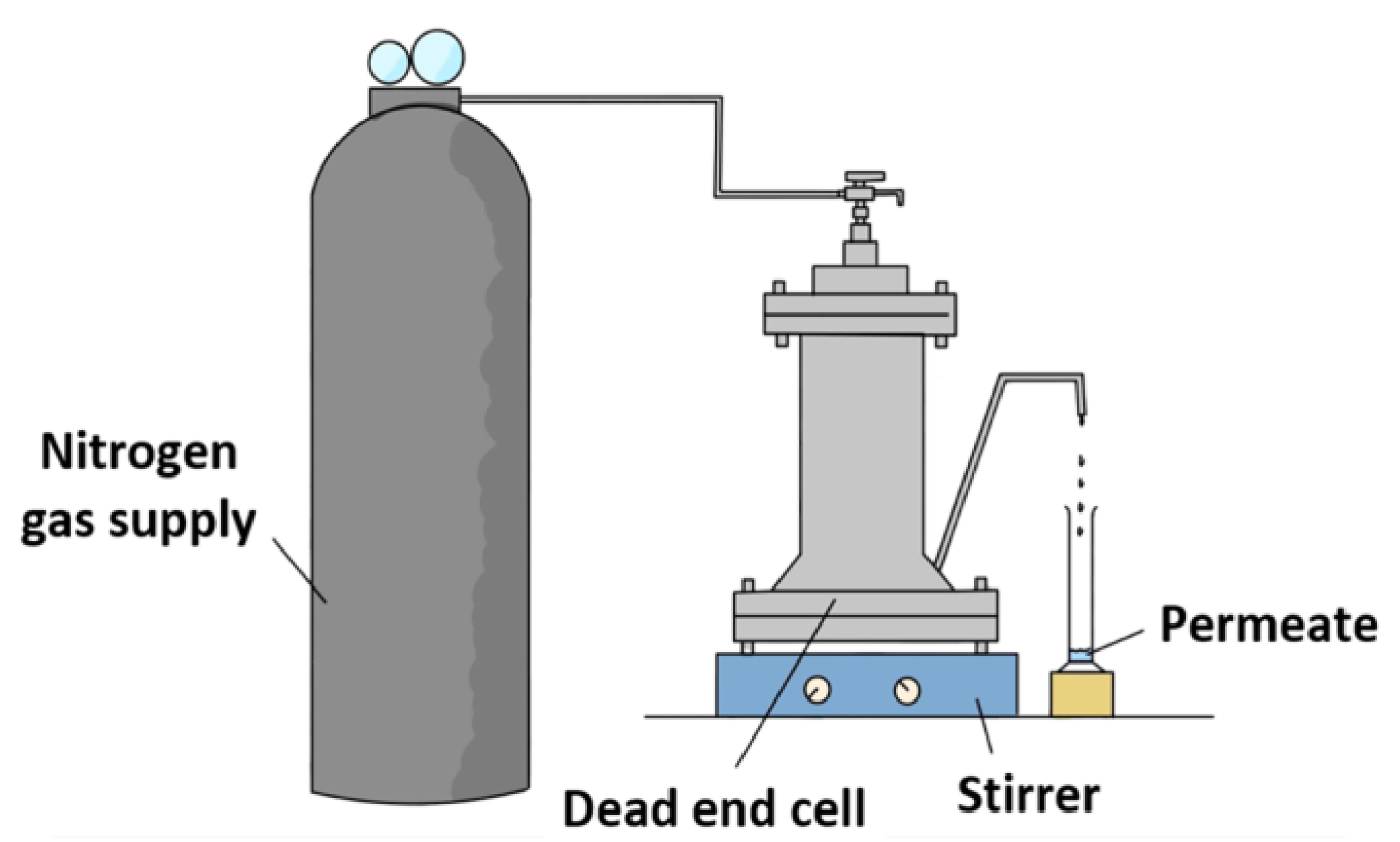

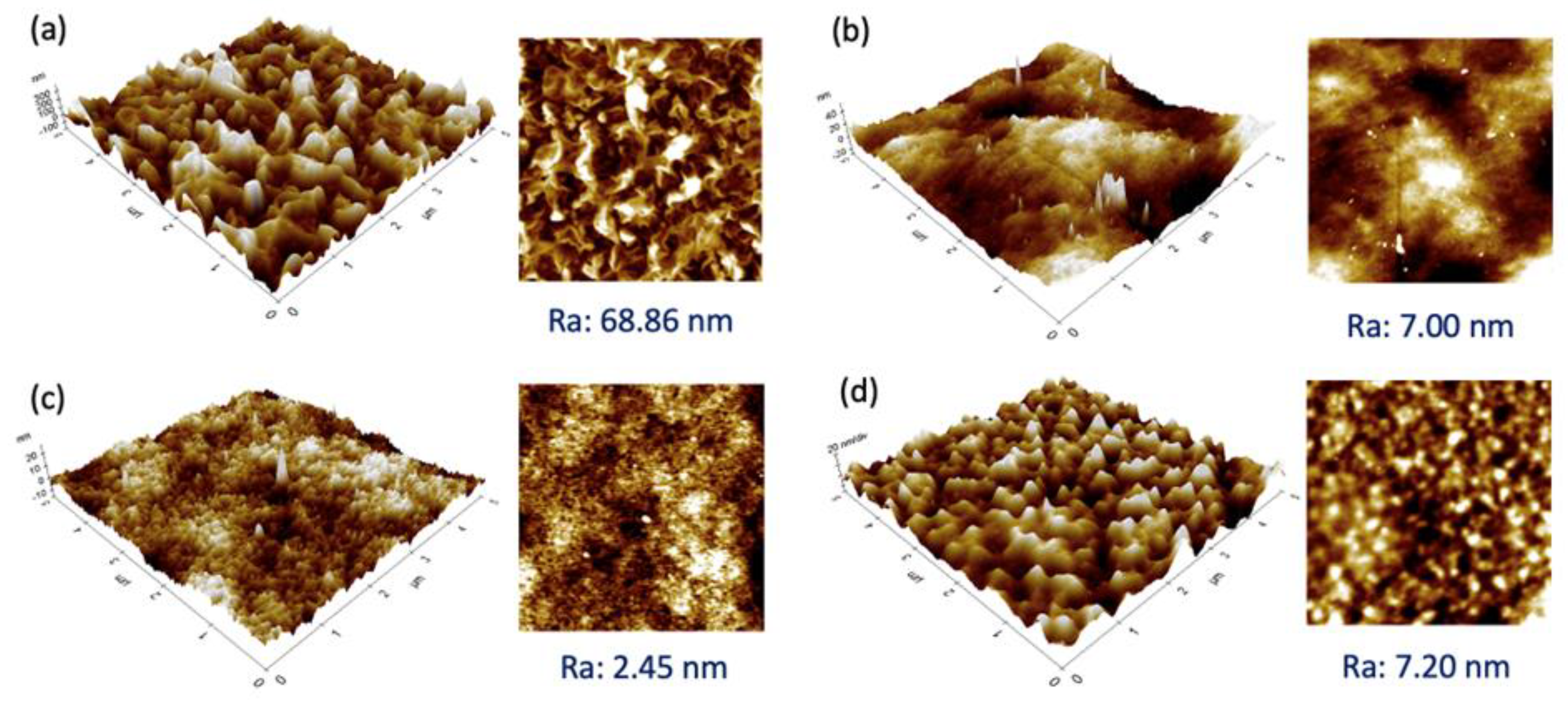

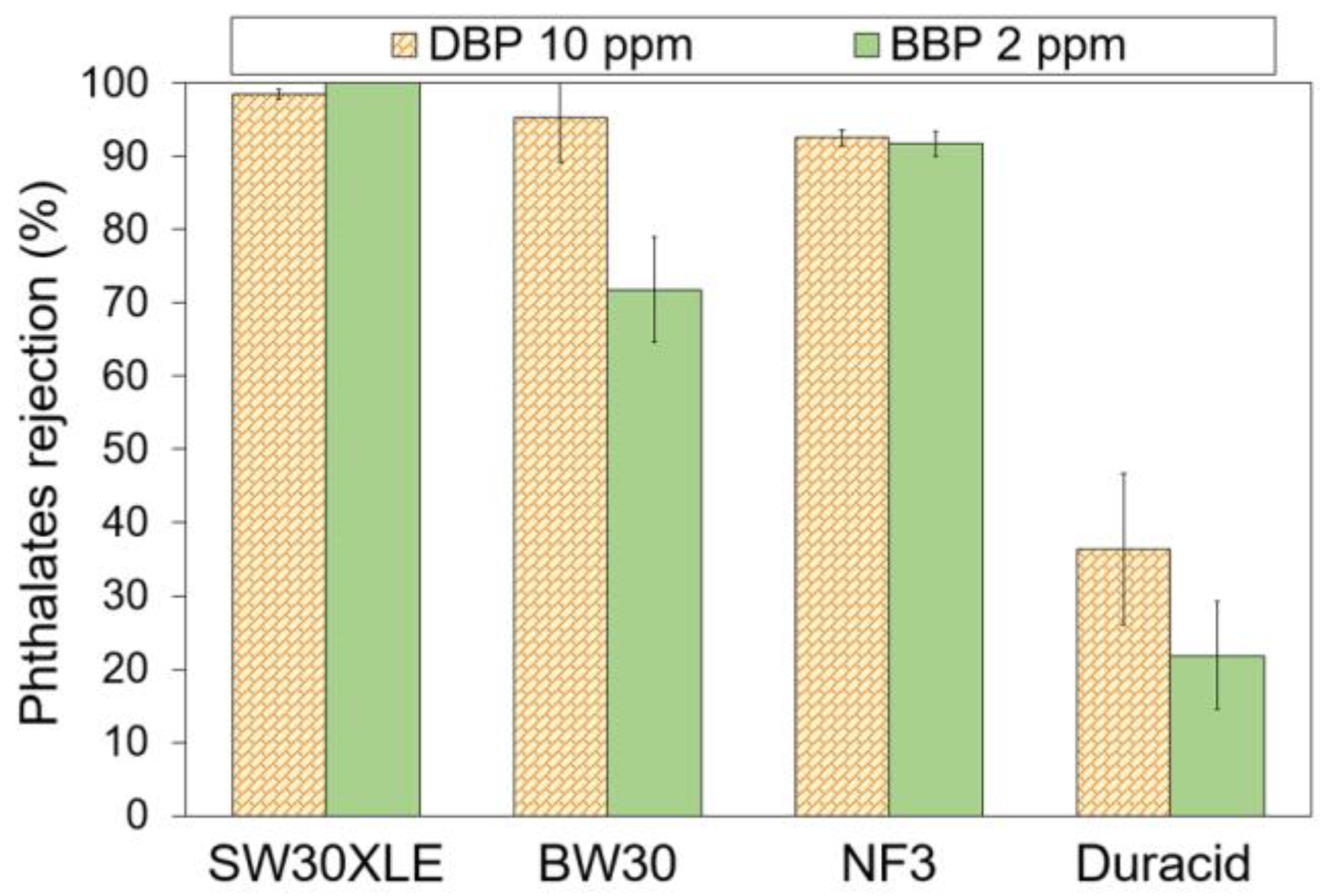
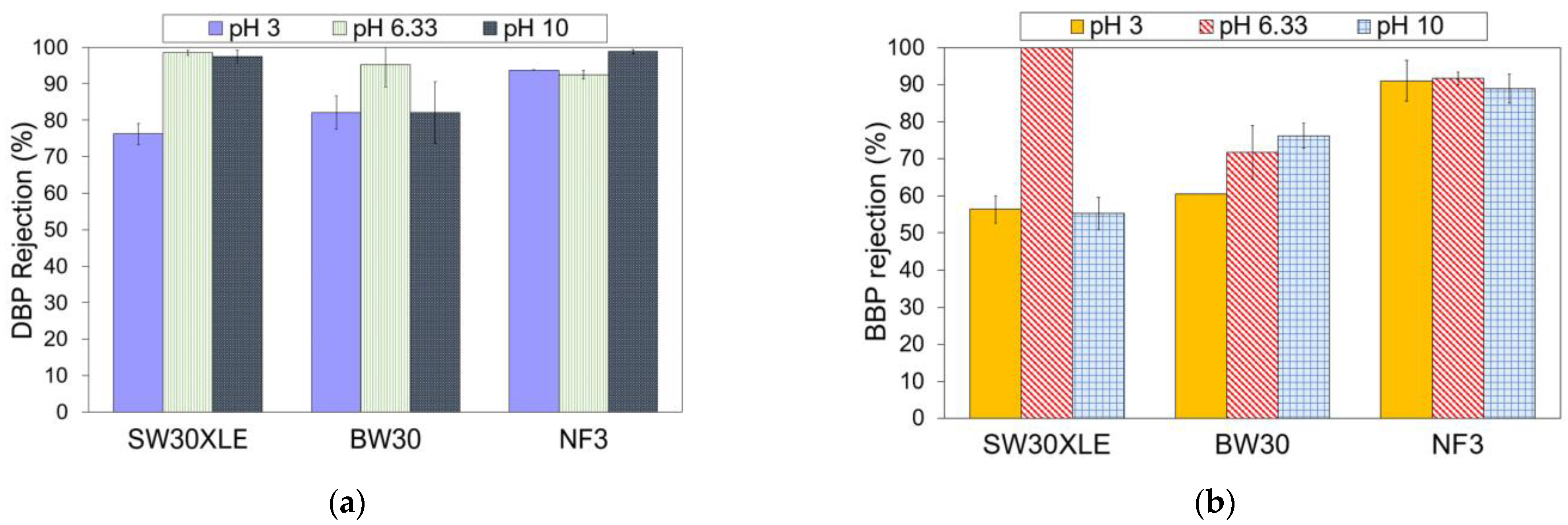

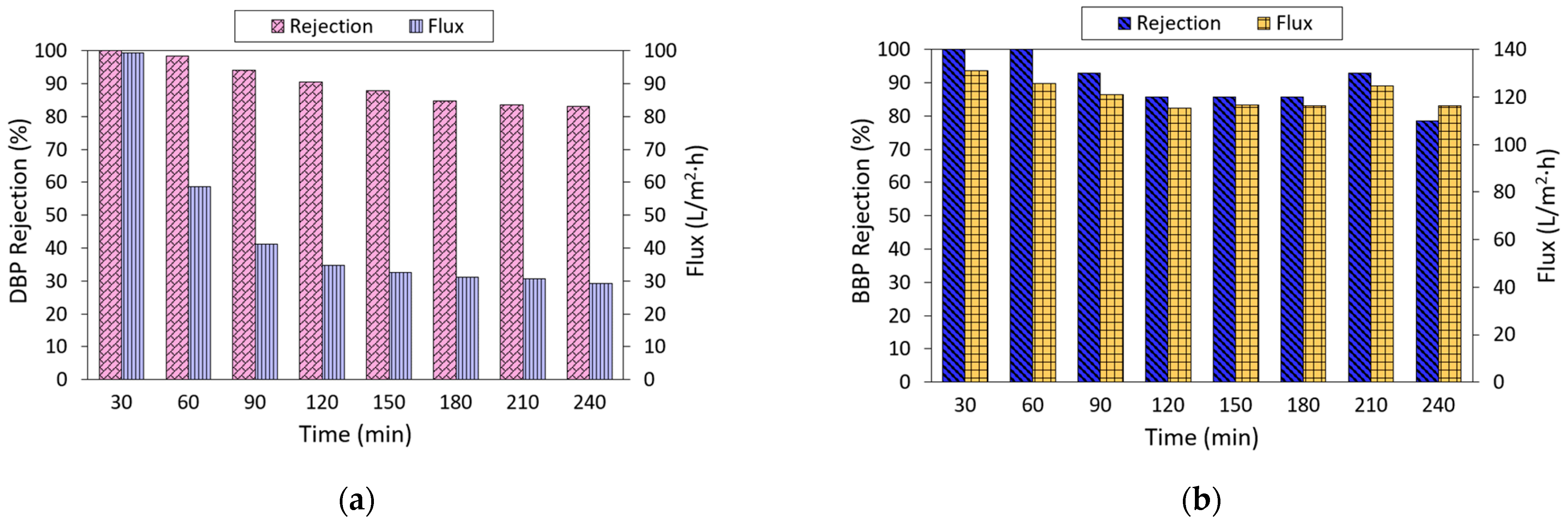

| Phthalates | Chemical Formula | Molar Mass (g/mol) | Melting Point (°C) | Boiling Point (°C) | Relative Density (Water = 1.0) (g/cm3) | Solubility in Water (mg/L) | Ref. |
|---|---|---|---|---|---|---|---|
| Di-2-ethylhexyl phthalate | C24H38O4 | 390.6 | −46 | 384 | 0.986 | 0.270 | [9,10] |
| Diisononyl phthalate | C26H42O4 | 418.6 | −48 | 252 (at 5 mm Hg) | 0.980 | 0.200 | [9,11] |
| Diisodecyl phthalate | C28H46O4 | 446.7 | −46 | 253 (at 4 mm Hg) | 0.960 | 0.280 | [9,12] |
| Di-n-octyl phthalate | C24H38O4 | 390.6 | −25 | 220 (at 2 mm Hg) | 0.978 | 0.022 | [9,13] |
| Dibutyl phthalate (DBP) | C16H22O4 | 278.4 | −35 | 340 | 1.050 | 11.200 | [9,14] |
| Butyl benzyl phthalate (BBP) | C19H20O4 | 312.4 | −35 | 370 | 1.100 | 2.690 | [9,15] |
Disclaimer/Publisher’s Note: The statements, opinions and data contained in all publications are solely those of the individual author(s) and contributor(s) and not of MDPI and/or the editor(s). MDPI and/or the editor(s) disclaim responsibility for any injury to people or property resulting from any ideas, methods, instructions or products referred to in the content. |
© 2023 by the authors. Licensee MDPI, Basel, Switzerland. This article is an open access article distributed under the terms and conditions of the Creative Commons Attribution (CC BY) license (https://creativecommons.org/licenses/by/4.0/).
Share and Cite
Lim, E.Q.; Seah, M.Q.; Lau, W.J.; Hasbullah, H.; Goh, P.S.; Ismail, A.F.; Emadzadeh, D. Evaluation of Surface Properties and Separation Performance of NF and RO Membranes for Phthalates Removal. Membranes 2023, 13, 413. https://doi.org/10.3390/membranes13040413
Lim EQ, Seah MQ, Lau WJ, Hasbullah H, Goh PS, Ismail AF, Emadzadeh D. Evaluation of Surface Properties and Separation Performance of NF and RO Membranes for Phthalates Removal. Membranes. 2023; 13(4):413. https://doi.org/10.3390/membranes13040413
Chicago/Turabian StyleLim, En Qi, Mei Qun Seah, Woei Jye Lau, Hasrinah Hasbullah, Pei Sean Goh, Ahmad Fauzi Ismail, and Daryoush Emadzadeh. 2023. "Evaluation of Surface Properties and Separation Performance of NF and RO Membranes for Phthalates Removal" Membranes 13, no. 4: 413. https://doi.org/10.3390/membranes13040413
APA StyleLim, E. Q., Seah, M. Q., Lau, W. J., Hasbullah, H., Goh, P. S., Ismail, A. F., & Emadzadeh, D. (2023). Evaluation of Surface Properties and Separation Performance of NF and RO Membranes for Phthalates Removal. Membranes, 13(4), 413. https://doi.org/10.3390/membranes13040413










